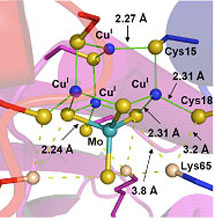

Monday - June 14, 2010
SLAC Today is
available online at:
http://today.slac.stanford.edu
In this issue:
SSRL Science Highlight: Research Sheds Light on Workings of Anti-cancer Drug
Colloquium Next Monday: The Mars Science Laboratory
 |
 |
|
Monday - June 14, 2010 |
SSRL Science Highlight: Research Sheds Light on Workings of Anti-cancer Drug Structure of the nest-shaped copper-binding cluster in the TM-copper-protein complex with average interatomic distances. (Image courtesy the researchers.)
Cells need copper to function, but too much copper can be toxic, leading to liver damage and neurological problems, as happens in disorders such as Wilson disease. The inorganic small molecule tetrathiomolybdate, or TM, assumed to be a copper chelator, is commonly used to treat Wilson disease. TM may also be an effective treatment of some cancers, acting by starving the cancer cells of the copper they need to grow. Despite its common use, TM's molecular mechanism was unknown. A team of researchers led by Thomas O'Halloran and Alfonso Mondragon of Northwestern University and Jim Penner-Hahn of University of Michigan used Beamline 9-3 at the Stanford Synchrotron Radiation Lightsource to determine the structure of TM bound to copper and its chaperone protein. They were surprised to find that TM does not simply sequester copper from the copper chaperone, but binds to a nest-shaped copper-protein complex, completely disrupting the copper transport system. Understanding how TM can shut down the copper ferrying system could lead to treatments for some cancers, since growing cancers require a supply of copper. TM may also be useful for treating other diseases, such as familial amyotrophic lateral sclerosis, Parkinson's disease, multiple sclerosis, Alzheimer's disease and some disorders associated type II diabetes. The research was published in the January 15 issue of Science. To learn more about this research see the full scientific highlight. Colloquium Next Monday:
|
Events (see all | submit)
Access (see all)
Announcements
|
|
| | ||
|
|
||
 <%
Response.AddHeader "Last-modified", getArticleDate()
'Response.AddHeader "Last-modified","Mon, 01 Sep 1997 01:03:33 GMT"
'Monday, December 06, 2010
%>
<%
Response.AddHeader "Last-modified", getArticleDate()
'Response.AddHeader "Last-modified","Mon, 01 Sep 1997 01:03:33 GMT"
'Monday, December 06, 2010
%>View online at http://today.slac.stanford.edu/. |
||